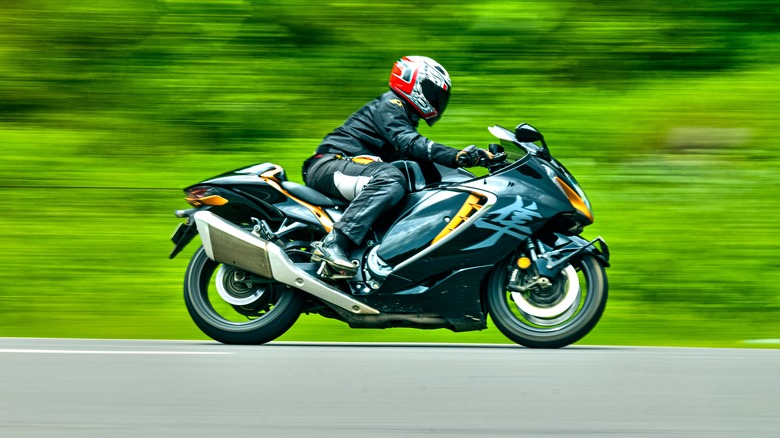
Harman01828/Shutterstock
Technology has come a long way since the first motorized cycle was dreamed up in the late 1800s, as designers and manufacturers have been continously coming up with faster, better-engineered bikes. Today, there are dozens of different makes and models to choose from, from quirky little city-hoppers to highly engineered speed demons.
Of course, if you’re really into motorcycles, you’ve doubtless heard of the Suzuki Hayabusa. First released in 1999, the Hayabusa is named after the Japanese word for Peregrine Falcon. True to its name, this bird of prey swooped into the motorcycle industry and helped change history.
Today, we’re taking a look at what makes the Hayabusa so special, from its record-breaking origins to its long-lasting appeal. Here are 10 things every motorcycle rider should know about the Suzuki Hayabusa. Whether you’re a long-time fan of the model or just curious about this legendary bike, these insights will deepen your appreciation for one of the most influential motorcycles ever built.
Origins of the Hayabusa
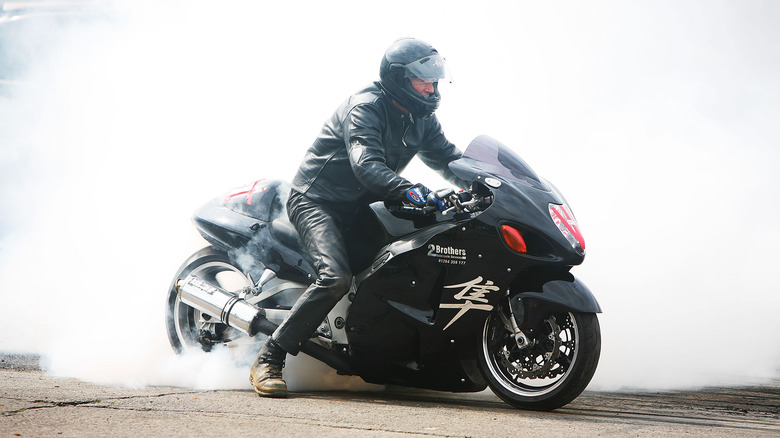
Louise Wilson/Getty Images
The launch of the first Hayabusa in 1999 marked a significant milestone for Suzuki and the motorcycle industry as a whole. Created by designer Koji Yoshiura, it quickly emerged as a key model in the Suzuki motorcycle lineup, revolutionizing the market. Prior to its arrival, Honda had been the go-to manufacturer for those seeking fast, sporty bikes.
When the Hayabusa hit the market, its odd, bulky shape got riders’ attention, but its record-shattering speed and handling kept it. Suzuki’s Hayabusa played a pivotal role in dethroning Honda as the premier sportbike manufacturer, going on to set new speed records and even spawning a new category of motorcycles.
To this day, the Suzuki Hayabusa is still celebrated for the numerous speed records it holds and its huge, dedicated fan base. Suzuki has kept the Hayabusa in production, continually updating and refining it, ensuring that it remains a top choice among sportbike enthusiasts worldwide.
What’s in a name?
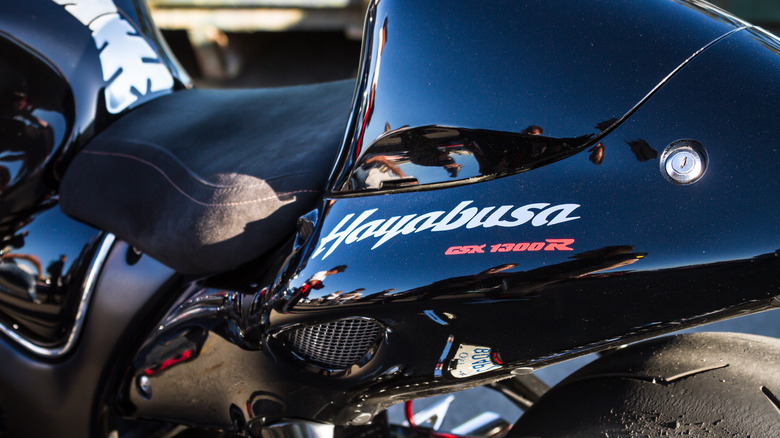
Labrynthe/Shutterstock
Hayabusa -– it’s a name that resonates with speed and agility in the world of sports bikes, a direct nod to the Peregrine Falcon, Japan’s fastest bird. However, there’s an interesting twist to this name that goes beyond just a quick bird.
The Peregrine Falcon is a bird that’s celebrated for its incredible speed, which perfectly mirrors the reputation of the Hayabusa as the fastest production motorcycle in the world. Suzuki wasn’t just aiming for a name that echoed the bike’s speedy engineering — there’s a bit of an insider nod here, too, one that Suzuki has intriguingly never confirmed nor denied.
The plot thickens when you consider the Peregrine Falcon’s natural behavior. It’s a hunter known for targeting other birds. When the Hayabusa made its grand entrance in 1999, it went head-to-head with the undisputed champion at the time –- Honda. Specifically, one of its biggest direct competitors was the Honda Blackbird. In a twist of nature-meets-technology, the Hayabusa, much like its namesake, swooped into Honda’s territory, challenging the Blackbird’s reign.
This wasn’t just another bike on the block; it symbolized Suzuki giving Honda a run for their money with another bird-themed bike in the high-speed motorcycle race.
Top speed
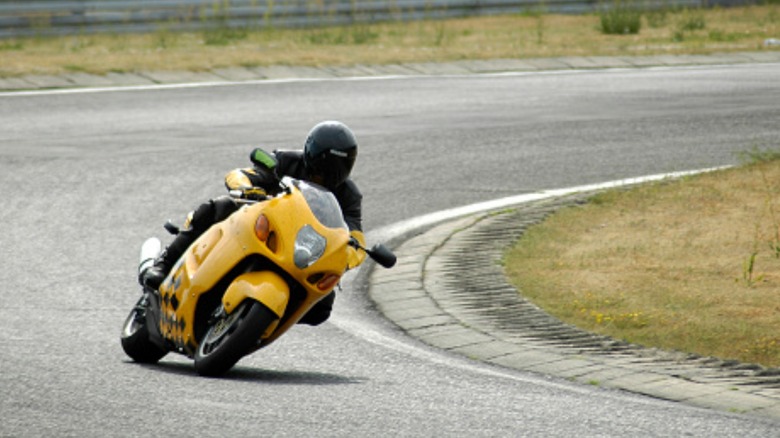
Sweetmoments/Getty Images
When the Hayabusa first zoomed onto the streets in 1999 it was more than just another new bike — it was the fastest thing on two wheels. It caught everyone’s attention by outpacing every other bike on the market by about 10 mph. Funnily enough, the engineers of the Hayabusa maintain that the original wasn’t specifically going for the title of the fastest bike.
In fact, the original designer of the Hayabusa, Koji Yoshiura, told MCN that its incredible performance was the result of «pursuing the best handling, acceleration, safety, power, riding ability, original styling, etc., for the good of the customers.» The record-setting top speed just happened to be an exciting by-product of these aims. Suzuki made good on those goals, as the original Hayabusa may have been a bit odd looking, but its handling, rideability, and fun factor immediately made it one of the most popular bikes of the time.
When it first hit the road, the original Hayabusa boasted a jaw-dropping max speed of nearly 200 mph. This instantly made it a magnet for speed enthusiasts and gearheads. Straight off the assembly line, without any tweaks or special gear, the Hayabusa was the fastest motorbike you could get your hands on.
Winning the title
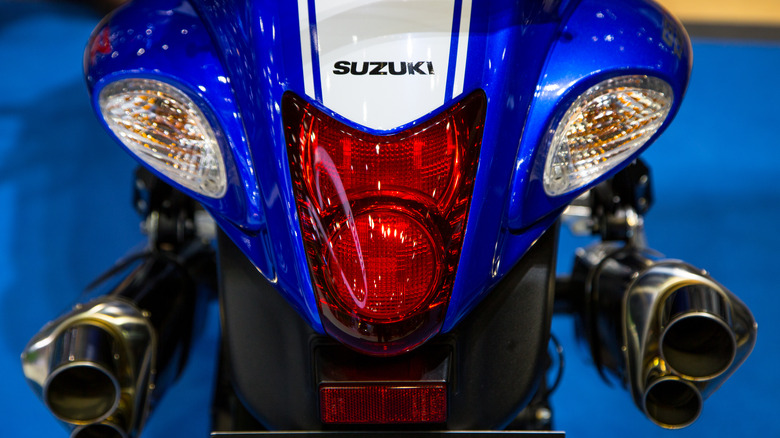
Itsanan/Shutterstock
In 1999, the Hayabusa earned the distinction of being the world’s fastest production motorcycle. Since then, however, technology has evolved and motorcycles have been built that surpass the Hayabusa’s top speed, yet the Hayabusa remains one of the fastest bikes you can buy off the lot.
This is because most bikes released after 2000 were electronically capped at a maximum speed of 185 mph. This self-imposed limit resulted from a gentleman’s agreement among manufacturers — one which was largely seen as a response to rumors that the EU might begin placing sanctions on bikes that were too fast to be considered safe. By capping speeds, manufacturers aimed to comply with potential import regulations and avoid a decline in sales. This had the unintended consequence of leaving the Hayabusa at the peak end of allowable speed.
In the years following, while engineering and speed capabilities advanced, and even the Hayabusa itself was modified for greater speeds, most (but not all) manufacturers continued to adhere to this 185mph limit. This electronic limitation has become a standard practice, preserving Hayabusa’s legacy as one of the fastest production motorcycles within these constraints.
Impressive engine
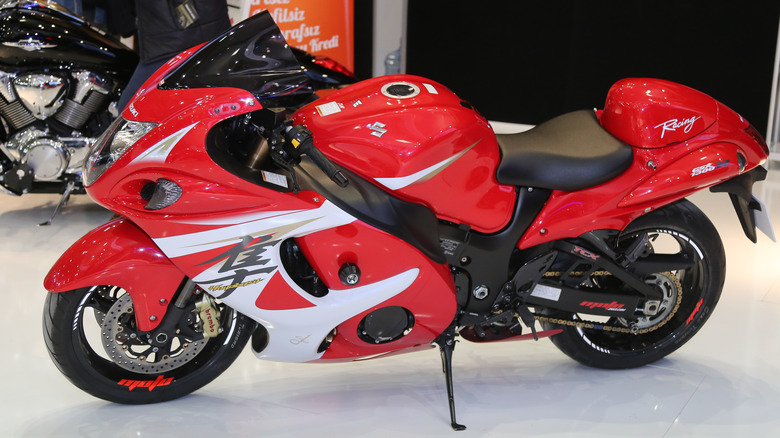
EvrenKalinbacak/Shutterstock
The engine of the Hayabusa was designed with efficiency and versatility in mind. This combination has not only enhanced the bike’s reputation but also sparked a range of innovative side projects utilizing the Hayabusa engine.
One of the more amusing endeavors by Hayabusa enthusiasts involves retrofitting Smart cars with the Hayabusa engine. The original Smart car, with a modest 89 horsepower, transforms dramatically when equipped with the Hayabusa engine. This swap turns the lightweight, ¾ ton car into a powerhouse capable of reaching around 300 horsepower. The result is a rather quirky and overpowered Smart car –- a project more about fun and engineering creativity than practicality.
The Hayabusa engine has been part of more serious and ambitious projects as well. One notable example is a team of engineers who set out to reconstruct the Bugatti 100P airplane. This aircraft, designed just before World War II, was considered one of the fastest of its time, potentially reaching speeds of up to 500 mph. However, it was dismantled during the war to prevent it from being seized by the Nazis, and no original blueprints survived. The team, starting from scratch, chose to power their replica with not one but two Hayabusa engines, demonstrating the engine’s adaptability beyond the world of motorcycles.
Ugly original?
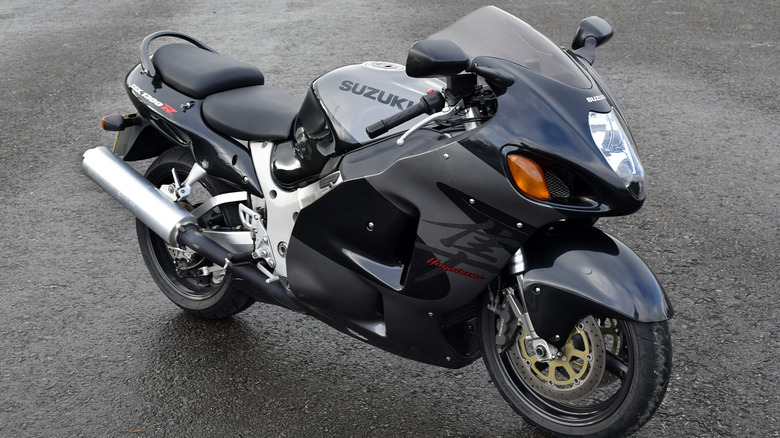
Heritage Images/Getty Images
When the Hayabusa first zoomed onto the scene, it was a game-changer in terms of design. It looked nothing like any other bike around. It was a mix of what seemed like bulkiness paired with sleek, aerodynamic curves. Today, this unique design has become a signature trait of the Hayabusa.
Koji Yoshiura, the original designer behind this iconic bike, discussed Hayabusa’s distinctive style in an interview with MCN. Yoshiura wasn’t just aiming for a flash-in-the-pan kind of design — he wanted something timeless. So, he went for something radically different. As he mentioned in an interview, «My aim was to create a somewhat grotesque design and create a strong initial impact.»
The Hayabusa certainly did make an impact. It wasn’t just a head-turner with its looks; it backed up its bold style with equally impressive performance. The strategy was pretty clever –- grab attention with its unique look, then reel in enthusiasts with its blazing speed and top-notch engineering. Over the years, the Hayabusa’s design has evolved, maintaining its original silhouette while boosting performance. The newer generations feature aerodynamic tweaks like vents and air diffusers, proving that this bike isn’t just about looks –- it’s a continually evolving beast on the road.
The Hayabusa Station Festival
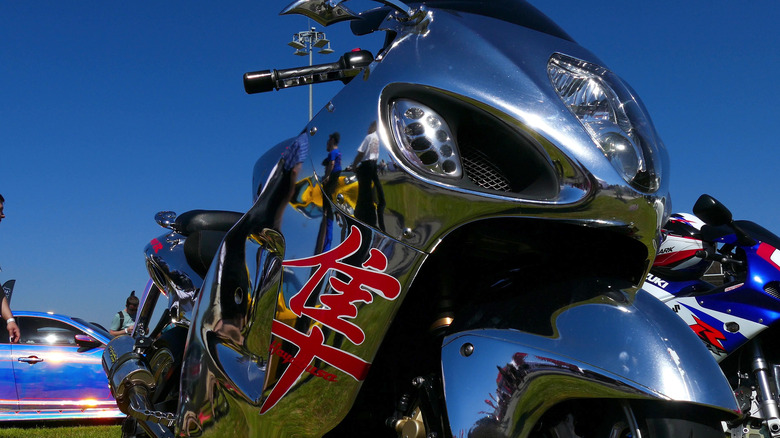
Pavel Shlykov/Shutterstock
Tucked away in the quaint town of Yazu in Japan’s Tottori prefecture, Hayabusa Station shares its name with the Peregrine Falcon and the famed Hayabusa Shinkansen bullet train. Back in 2009, a bunch of Hayabusa bike owners had the idea to have a meet-up right at this station that bears the same name as their favorite bikes.
What started as a fun idea turned into an annual tradition. Every August, Hayabusa riders rev up their engines and head to the Hayabusa Station Festival. It’s become a real celebration of everything Hayabusa -– a place for riders to connect, share their passion, and, of course, show off their bikes. Each year, the festival just keeps getting bigger. It was briefly postponed due to COVID-19 restrictions, but in 2023, it came back full throttle with over 2,600 attendees and 2,300 bikes from various generations.
The festival is more than just a gathering. It’s packed with talks from Hayabusa engineers, plenty of photo opportunities, food stalls, and rallies, and it even wraps everything up with a speech from the Suzuki president. It’s events like these that really show the strength and dedication of a fan base — a community of riders coming together to celebrate their shared love for the Hayabusa.
Hayabusa in pop culture
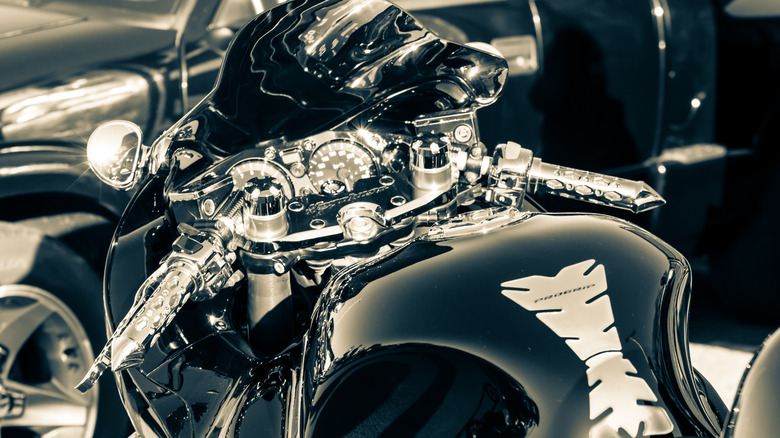
Labrynthe/Shutterstock
The Hayabusa isn’t just a star on the roads, as it’s also made quite a splash in pop culture. Its distinctive body style and status as a top-tier sports bike have made it a go-to choice for music videos, TV shows, and movies. Whenever there’s a need to showcase speed and style, the Hayabusa often steals the scene.
Take the «Thunder Gun Express» episode of «Always Sunny in Philadelphia,» for example. In a wild chase across town, the gang’s antics include hijacking boats, dashing through sewers, and attempting to tear up the streets on a GSX 1300 Hayabusa. They’re channeling the bravado of the fictional action star John Thundergun, and the Hayabusa fits right into this high-octane narrative. That kind of instant recognition as a symbol of speed makes the Hayabusa a favorite for directors.
Even in the world of TV dramas, the Hayabusa has its moment, and it can also be seen in the remake of «Hawaii Five-0,» where it shows up in Season 6. The music industry loves it, too, with artists like Mos Def, The East Side Boyz, and Three 6 Mafia all featuring the Hayabusa in iconic music videos. Its unique look, unmatched speed, and solid reputation make the Hayabusa easily recognizable on screen. It’s not just a bike — it’s a symbol of speed and style, which makes it a favorite among those looking to add a touch of adrenaline to their visuals.
Hayabusa generations
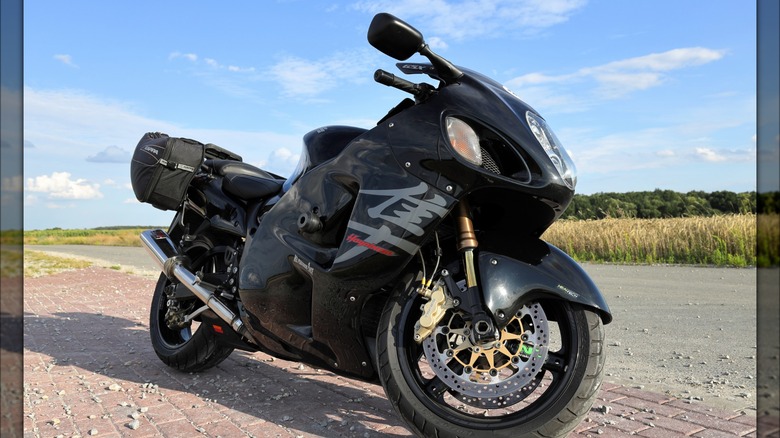
Joanna Sokolowska/Getty Images
Since its debut in 1999, the Hayabusa has evolved through three major generations, each building upon its predecessor with new technology and engineering. Despite these advancements, for many purists and collectors, the original model will always be the most sought-after.
The first generation was produced from 1999 to 2007. This version broke speed records, reaching upwards of 190 mph. However, finding a first-generation Hayabusa in its original condition has become increasingly challenging. Many of these bikes have been modified over the years, and an intact, stock version is hard to come by or quite costly. Though these original models still exist, purchasing a brand-new Hayabusa might be a more economical option.
The second generation spanned from 2008 to 2012 and got a power upgrade. This iteration featured a 1340cc engine, slightly larger than the first generation’s 1298cc. The body design was largely unchanged, with minor updates in electronics. In 2013, the second generation was promoted to 2.5, incorporating an automatic brake system (ABS) and improved brake calipers.
The year 2022 saw the release of the current generation. The newest third-gen 2022 Suzuki Hayabusa sparked some debate, as it is significantly more expensive than the second generation and technically has less power. The decrease in power was a strategic move to enhance emissions ratings, fuel efficiency, and handling. However, it compensates with significant technological advancements, like sophisticated ABS, cruise control, and lift systems.
Hayabusa’s legacy
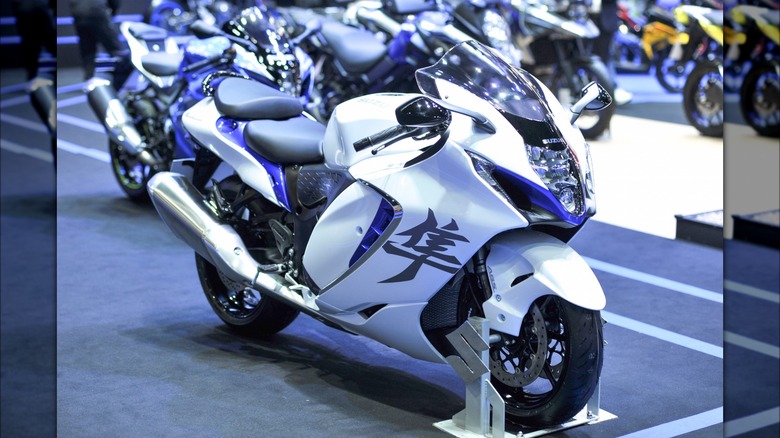
chin797/Shutterstock
The Hayabusa still stands today as a testament to motorbike history. Faster bikes have been made since its debut in 1999, but the Hayabusa is still as popular as ever.
Suzuki made automotive history when it dethroned Honda as the defacto king of the motorbike industry with the Hayabusa. It even created a whole new category of bikes dubbed ultimate sport, fundamentally changing the industry and indirectly forcing manufacturers to agree to limit their bikes to avoid import restrictions. Today, the Hayabusa maintains its reputation for speed, style, and reliability. First-generation Hayabusas are considered collector bikes now, and there’s a healthy aftermarket for the second generation.
The third-generation Hayabusa has seen a refinement of its iconic design. It features a sleeker, more aerodynamic body, moving away from the bulkiness of its predecessors. This model isn’t just about aesthetics — it comes equipped with advanced technology, enhancing its performance and appeal. Despite being more expensive than earlier models, it remains a top choice for sportbike enthusiasts around the world, a testament to the enduring legacy of the Hayabusa in the realm of high-performance motorcycles.